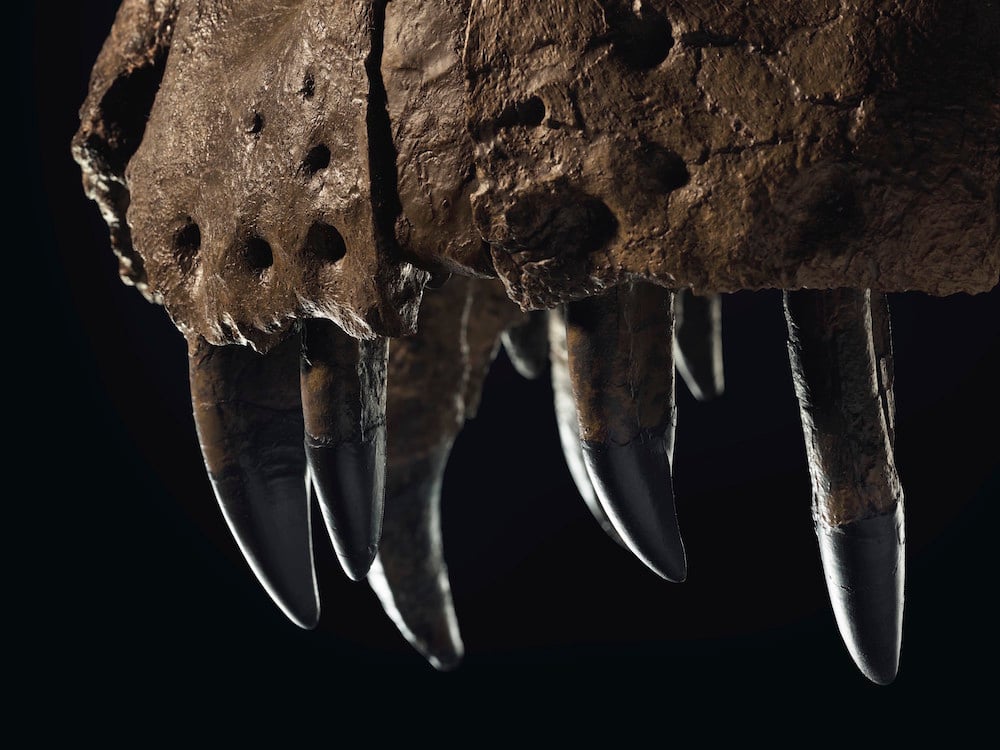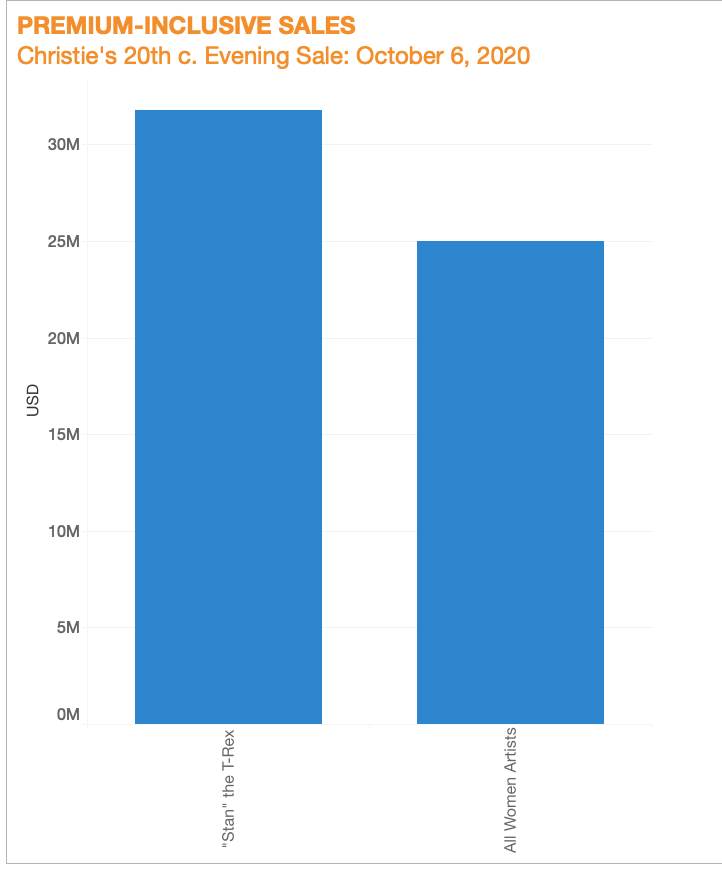Every Monday morning, Artnet News brings you The Gray Market. The column decodes important stories from the previous week—and offers unparalleled insight into the inner workings of the art industry in the process.
This week, analyzing what a blast from the (distant) past means for the present…
“STAN” AND DELIVER
Last Tuesday, Christie’s roared to a $341 million total at its 20th-century art evening sale, in part by riding an unusual steed: the skeleton of a Tyrannosaurus Rex (nicknamed “Stan”) that more than tripled its $8 million high estimate to reach $31.8 million after fees. But while the mega-fossil’s outsized success is a definite win for Christie’s bottom line, it also chomps directly into fundamental questions about how business is done at the apex of the 21st-century auction market.
Let’s start with the narrowest focus and expand from there. The most obvious question concerns categories: Why was Christie’s offering a T-Rex skeleton alongside 54 blue-chip artworks in its most prestigious auction of the young fall season?
The main answer is visibility. The house’s 20th-century evening sales are its biggest global platform, meaning that anything offered there will be seen by more potential buyers with more money to blow than in any of its other auctions. It seems like the discrepancy in audience size would have been especially wide in the case of “Stan,” which would normally have ended up in one of Christie’s science and natural history sales among fellow lots like meteorite fragments, vintage globes, and the remnants of animals “Stan” may have eaten. Unlike blue-chip artworks, this isn’t exactly a market that the world’s swashbuckling billionaires regularly monitor for treasures that can win them global bragging rights.
So this skeleton formed at least 66 million years ago stomped into an evening sale of 20th-century art instead, backed by the (frankly kind of ingenious) narrative that the first T-Rex fossils were discovered in 1900 and 1902, instantly transforming the “king of the dinosaurs” into a cultural phenomenon that was still capturing imaginations by the debut of Michael Crichton and Steven Spielberg’s Jurassic Park in 1993.
In other words, the T-Rex was both a literal discovery of the 20th century, and a visual icon of the era—a duality James Hyslop, head of Christie’s science and natural history department, really put his back into by declaring before the sale that “T. rex is a brand name in a way that no other dinosaur is… It sits very naturally against a Picasso, a Jeff Koons, or an Andy Warhol.”
Auction houses have been selectively chiseling away category distinctions for years. Prior to last week, the most prominent recent example was Christie’s selling Leonardo da Vinci’s Salvator Mundi for a brain-blistering $450.3 million in what was ostensibly a Postwar and contemporary art evening sale in November 2017. Yet there have been plenty of quieter instances, too, like when Sotheby’s sold a pair of Georgia O’Keeffe paintings from the 1920s in its November 2018 contemporary evening sale.
In that sense, “Stan” reinforces how thoroughly auction houses have absorbed a lesson seared into pop culture by Matthew McConaughey in the first season of True Detective: time is a flat circle. Regardless of when it comes from, the right object can be positioned into a sales slate to maximize demand. That’s it. With enough creativity (and a little brazenness), you can justify any placement if you believe it will help get the right buyers to compete.
But this also leads to a more disappointing, more socially relevant fact about the art market—another one that “Stan” brought to life in a vivid way last week.

A detail of “Stan,” the T-Rex skeleton sold by Christie’s. Image courtesy Christie’s.
NO BONES ABOUT IT
Instead of parsing the results of Christie’s 20th-century evening sale by era or object type, another jarring imbalance emerges if we parse them by gender. Among the 55 lots offered there, only five were artworks by women artists, meaning 53 were artworks by men… and then, oh yeah, there was a dinosaur skeleton. Throw out “Stan” as a novelty, and the gender ratio of the actual artists in the auction comes down to nine men to one woman behind the easel. The imbalance is even starker by value: roughly $284 million spent on works by men, versus about $25 million for works by women.
But the most awkward comparison of all appears if we herd “Stan” back into the picture. Again, the fossil sold for $31.8 million—about $6.8 million more than all five women artists in the sale combined.

© Tim Schneider 2020.
In fairness to Christie’s, there are a slew of mitigating factors here. For starters, the secondary market for blue-chip women artists has definitely heated up over the past couple of years. Case in point: the latest issue of the Artnet Intelligence Report relayed that 15 women made the list of the 100 top-selling artists at auction in the first half of 2020, which is more than twice as many women as in the first half of 2019. Christie’s also offered nine works by women in the first 15 lots of last Wednesday’s postwar and contemporary art day sale. (For the uninitiated, the first set of lots in an auction is where the power and glory concentrates.) Seven of those works landed above their respective high estimates after fees.
The rising interest in works by women means Christie’s and the other major auction houses are now scouring the earth for prime examples by recognized titans of the fairer (also: smarter, deeper, subtler, more perceptive, more communicative, more collaborative, and generally more talented) sex. Ironically, though, this upsurge in demand has also undoubtedly made at least some potential consignors grip even tighter onto their works by great women. Why accept a $3 million guarantee for, say, a Joan Mitchell this fall if you think there’s a good chance it could fetch $4 million or $5 million next year, let alone even more if you hold on longer?
All of which is to say that specialists at auction houses aren’t oblivious to the extreme gender imbalance in the art market, and I have no doubt several of them are trying to reset the scales. But ultimately the prime objective is to make money. Slotting nine times more men than women into a sale of artworks spanning the entire 20th century—not just the especially testosterone-soaked Impressionist and art Modern period—speaks volumes about the types of artists still most in demand at the marketplace’s pinnacle in fall 2020.

Christie’s New York team handling bids for the “ONE” sale on July 10. Image courtesy of Christie’s.
BOY CRAZY
The estimates in the Christie’s sale were as telling as the sales figures in this regard. Sure, bidders went beast mode for “Stan,” propelling the fossil light years past its estimate of $6 million to $8 million. Yet only one work by a woman artist matched the dinosaur’s pre-sale valuation: Tamara de Lempicka’s Les deux amies (1930). The painting sold for a premium-inclusive $9.4 million—her third-highest price at auction per the Artnet Price Database, but still far south of “Stan.”
This too can be caveated, of course. The New York Times judged “Stan” to be the most complete T-Rex skeleton to come to auction since 1997, when Chicago’s Field Museum of Natural History acquired a remarkable fossil named “Sue” for just under $8.4 million (about $13.5 million today after adjusting for inflation). If you were in the market for T-Rex bones, then, there was no telling when another set as rare and remarkable as “Stan” would be available after this particular sale. That’s a classic recipe for a bidding war.
But the hunger is the point, not the extraordinariness of “Stan.” There were no indications that Cy Twombly’s Untitled (Bolsena), which skied past “Stan” to become the sale’s top lot at $38.7 million with fees, qualified as a once-in-a-generation painting; the same seems to be true for the untitled Mark Rothko that sold for $31.3 million, or only $500,000 less than the T-Rex. Both of those works out-earned the cumulative sales of the five women artists featured in the same auction, too.
Ultimately, the buying audience is the buying audience. They want what they want. Of course, this also begs the question of why blue-chip auction buyers skew so heavily toward male artists. Even beyond the enduring value assigned to the traditional, dude-centric Western art-historical canon, that’s a much more complex question that I’ll have more to say about a little later this month. Until then, the success of “Stan” is an object lesson for multiple realities of the high-end auction market in 2020. Let’s hope some of them crumble into dust by the time another T-Rex fossil appears on the block.
[Artnet News]
That’s all for this week. ‘Til next time, remember: inside and outside auction houses, it’s never been clearer than right now that time is just a construct, and the old inequities are still here.










